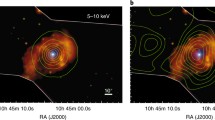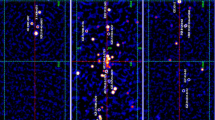Abstract
In a close binary system, the effects of irradiation are studied from an extended surface of the secondary component on the atmosphere of the primary. Primary and the secondary components are assumed to have equal radii and the thickness of the atmosphere is assumed to be twice that of the stellar radius of the primary component. Self radiation of the primary component (\(S_{s}\)) is calculated through a numerical solution of line transfer equation in the comoving frame with Compton broadening due to electron scattering. The solution is developed through discrete space theory to deal with different velocities in a spherically expanding medium. The irradiation from the secondary (\(S_{I}\)) is calculated using one dimensional rod model. It is assumed to be one, five and ten times the self radiation. The total source function \((S=S_{s}+S_{I})\) is the sum of the source functions due to self radiation and that due to irradiation. The line fluxes are computed along the line of sight by using the above source functions. Line profiles are also computed for different line center optical depths along the line of sight of the observer at infinity.
We noticed that the source functions against the optical depth show order of magnitude difference in the medium with and without reflection and also with the proximity of the secondary component. It is also noticed that the expansion of the medium produces P Cygni type profiles and the irradiation enhances the emission in the lines.











Similar content being viewed by others
References
Buerger, P.: Astrophys. J. 158, 1151 (1969)
Buerger, P.: Astrophys. J. 177, 657 (1972)
Claret, A., Gemenz, A.: Astron. Astrophys. 256, 572 (1992)
Edmonds, F.N. Jr.: Astrophys. J. 111, 298E (1953)
Edmonds, F.N. Jr.: Astrophys. J. 119, 58E (1954)
Kubat, J.: Astron. Soc. Pac. Conf. Ser. 214, 705K (2000)
Kubat, J., Puls, J., Pauldrach, A.W.A.: Astron. Astrophys. 341, 587K (1999)
Madej, J., Rozanska, A.: Astron. Astrophys. 356, 654 (2000a)
Madej, J., Rozanska, A.: Astron. Astrophys. 363, 1055 (2000b)
Madej, J., Joss, P.C., Rozanska, A.: Astrophys. J. 904, 602 (2004)
Norlund, A., Vaz, L.P.R.: Astron. Astrophys. 228, 231 (1990)
Peraiah, A., Rao, M.S.: J. Astrophys. Astron. 4, 175 (1983a)
Peraiah, A., Rao, M.S.: Astron. Astrophys. 4, 183 (1983b)
Peraiah, A., Srinivasa Rao, M.: Kodaikanal Obs. Bull. 12, 93 (1993)
Peraiah, A., Srinivasa Rao, M.: Astron. Astrophys. Suppl. Ser. 132, 45 (1998)
Peraiah, A., Srinivasa Rao, M.: Astrophys. Space Sci. 343, 195 (2013)
Pustynski, V.-V., Pustylink, I.: Astrophys. Space Sci. 299, 177 (2005)
Srinivasa Rao, M.: Serb. Astron. J. 180, 11S (2010)
Vaz, L.P.R.: Astrophys. Space Sci. 113, 349 (1985)
Vaz, L.P.R., Nordlund, A.: Astron. Astrophys. 147, 281 (1985)
Wilson, R.E.: Astrophys. J. 356, 613 (1990)
Acknowledgements
Authors would like to thank anonymous referee for his comments and suggestions which improved quality and the clarity of the manuscript.
Author information
Authors and Affiliations
Corresponding author
Appendices
Appendix A
Calculation of source function due to Compton scattering
The optical depth within the atmosphere is given
where \(dZ\) is the length, \(N_{e}\) is electron density and \(\sigma_{e}\) is the Thompson scattering coefficient given by
where \(e\) is the electron charge, \(m\) is the mass and \(c\) is the velocity of light. The emission coefficient for Compton scattering by electrons in thermal motion is given by (Edmonds 1953)
where primed quantities refer to the incident radiation, unprimed to the scattered radiation and
further, \(\nu\) \(\nu^{\prime}\) are the incident and scattered frequency of the radiation, \(d \omega^{\prime}\) increment of the solid angle about the direction of the incident radiation whose intensity is \(I(\nu^{\prime}, \tau, \mu^{\prime})\) and \(\varTheta\) the angle of scattering, is given by
The spectral distribution function for scattered radiation is given, to the second approximation (Edmonds 1954) as,
Here \(k\) is Boltzmann’s constant and \(h\) is the Planck’s constant. This function is asymmetric and the frequency shift of the scattered radiation corresponding to this asymmetry is given by Edmonds (1953) Frequencies are expressed in the form of \(\alpha\), \(\alpha^{\prime}\) Edmonds (1953, 1954), Peraiah and Srinivasa Rao (1993). \(\Delta\) is the Doppler width (\(\Delta=\frac{\nu_{0} v}{c}\), \(v\) mean thermal velocity, \(c\) is the velocity of light and \(\nu^{s}\) being the frequencies). The other parameters are \(k\) is the Boltzmann constant, \(m\) is the mass of the electron, \(T\) is the temperature of the gas
By introducing
and
Appendix B
As we mentioned in Sect. 3 the atmosphere of the primary component is divided into \(n\) shells, \(n=1\) shell corresponds to \(\tau=T\) and \(n=100\) is for \(\tau=0\) where \(\tau\) is the optical depth at any point and T is the total optical depth which is set in advance. Velocities of expansion are expressed in terms of mean thermal units \(V_{T}~\mbox{(mtu)}\) given by
The velocity at \(n=1\) (\(V_{A}\)) and the velocity at \(n=100\) (\(V_{B}\)) are given as
where \(v_{A}\) and \(v_{B}\) are the velocities of gas at the inner and outer radius of the primary star at radial point \(r\) measured in terms of mean thermal units (mtu). Uniform expansion of the gases is assumed for the sake of simplicity. The line profile fluxes \((F_{Q}/F_{c})\) are calculated and plotted against the normalized frequency \(Q\), where
and
\(x\) lies between \(\pm{5}\) units.
Rights and permissions
About this article
Cite this article
Varghese, B.A., Srinivasa Rao, M. Irradiation effects in close binaries in an electron scattering medium. Astrophys Space Sci 361, 92 (2016). https://doi.org/10.1007/s10509-016-2679-2
Received:
Accepted:
Published:
DOI: https://doi.org/10.1007/s10509-016-2679-2




